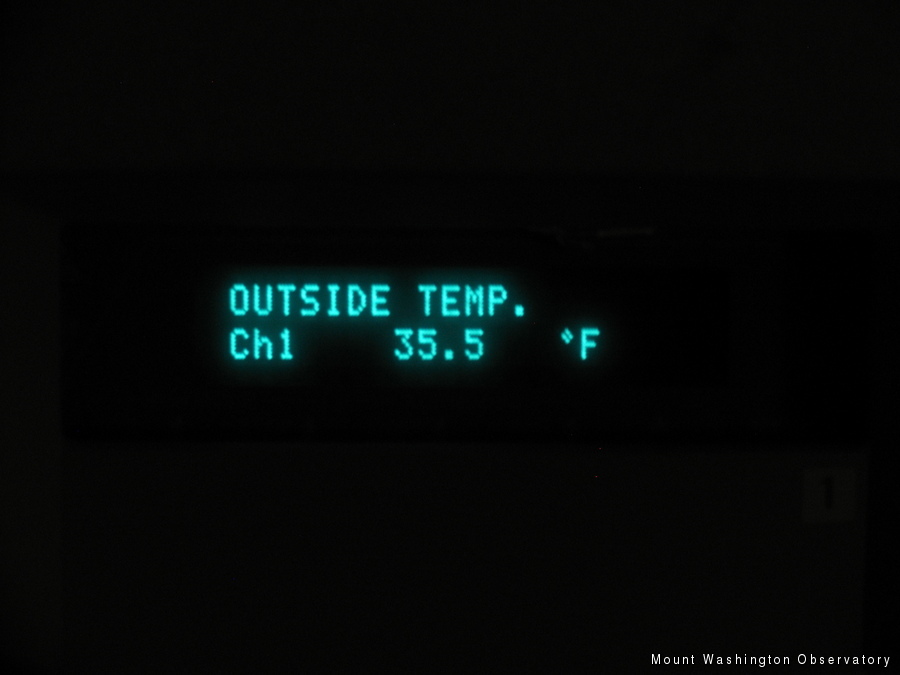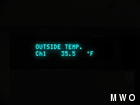Is it still summer?
2007-08-18 01:11:54.000 – Ryan Knapp, Meteorologist
Temperature read out at 2 am EDT
When I look at the forecast for the next 36 hours, I get an unsettled feeling in my stomach. It isn’t because I think I did an insufficient job forecasting. It isn’t because we have a potent storm forming nearby. It isn’t because we are going to break any ground shattering records and have the press swamp us. It is because of the temperatures and winds we will be getting will be creating some wicked wind chills for this time of year and there is bound to be at least one unprepared person out there.
Normally, August is one of our warmer months up here but over the next 36 hours, it will feel more like late fall rather than late summer. While valleys will be getting to temperatures in the mid 60s during the days, summits will be plunging below the freezing mark (32 Fahrenheit) tomorrow and will continue dropping until bottoming out Saturday night in the mid 20s before slowly rising (but still below freezing) on Sunday. Winds will be averaging between 50-70 mph during the day Saturday, 45-60 mph during the night Saturday, and 30-50 mph on Sunday. When you combine these two factors, you get wind chills on the order of 10-20 Fahrenheit Saturday, 0-10 Fahrenheit Saturday night, and 10-20 Fahrenheit Sunday.
For those who don’t know what a wind chill temperature is, it is the temperature it feels like to people (and animals). It is based on the rate of heat loss from exposed skin. The faster the wind is, the faster body heat is carried away which in turn lowers the skin temperature and eventually the internal body temperature. This in turn can bring about frostbite to exposed surfaces or hypothermia. Given the conditions this weekend, frostbite will set in to any exposed surfaces in a matter of 30 minutes especially in areas of the body with poor circulation.
So what are some things that you can do to prevent the effects of wind chill and possible frostbite? First, I would encourage hiking another time if possible. If you decide to make a go at it though, first check the forecast to see if anything has changed. Next, with the valleys being so “warm” and the summits so “cold,” dress in layers storing the extra layers in your pack, including a warm coat (LL Bean makes a few good ones that we wear). Make sure any clothing you are wearing is either made of wool or synthetic material, cotton is not a viable option. Wear thick wool socks or multiple layers of synthetic socks in good boots. Gloves are a must as well as a cap or balaclava of some sort. Pack plenty of food because you tend to burn more energy when it is colder. Insulate your water so it won’t freeze. Let others know of your plans or check in at a Visitor Center at the base of the summits. Some optional items to pack are goggles, hiking poles, crampons, and anything else you would normally pack for a late fall hike because it will definitely feel like it this weekend.
Ryan Knapp, Meteorologist
Team Flags Return for Seek the Peak’s 25th Anniversary
Team Flags Return for Seek the Peak's 25th Anniversary By MWOBS Staff Mount Washington Observatory is looking forward to continuing a much-loved tradition for Seek the Peak’s 25th Anniversary: Team flags. In inviting teams
Meet Summer Interns Zakiya, Max and Maddie
Meet Summer Interns Zakiya, Max and Maddie By MWOBS Staff We are excited to welcome six teammates to the summit of Mount Washington this summer! During their internship, these students and graduates will play
Saying Goodbye to the Summit
Saying Goodbye to the Summit By Alexis George After an extraordinary last three years working as a Weather Observer and Meteorologist, I am excited to pursue a different career. As sad I as am






